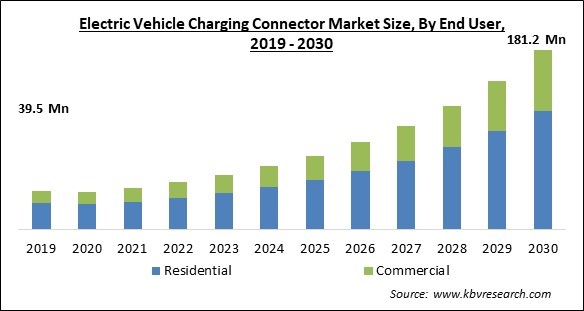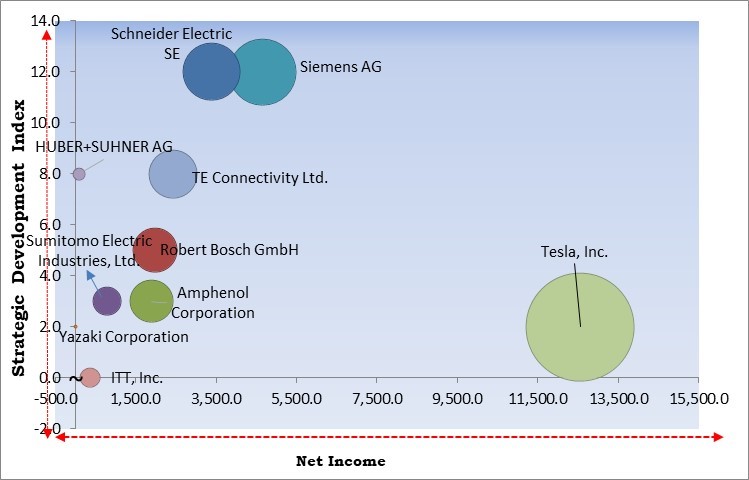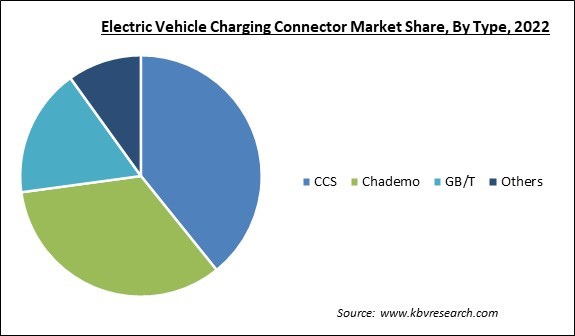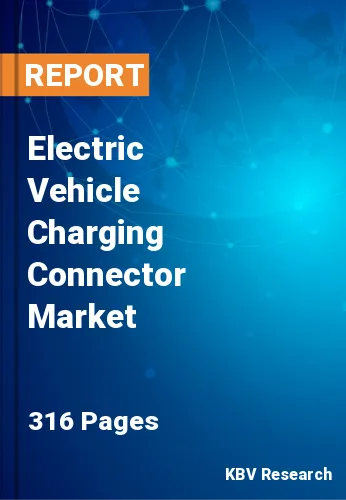The Global Electric Vehicle Charging Connector Market size is expected to reach $181.2 million by 2030, rising at a market growth of 18.6% CAGR during the forecast period.
The demand of public charging stations is growing due to increased EV sales. Most EV owners install a Level 1 EV charging unit in their homes or apartment building. Hence, Level 1 is anticipated to acquire more than 20% share of the market by 2030. From hatchbacks like the Blade to luxurious sedans like the Tesla Model 3, electric vehicles come in various sizes. The wide range of product options has attracted a lot of customers, leading to the emergence of an industry for electric vehicles. These investments and laws are probably going to help the market grow over the coming years.

The major strategies followed by the market participants are Partnerships as the key developmental strategy to keep pace with the changing demands of end users. For instance, In December, 2022, Bosch came into collaboration with Blink Charging Co. following which Bosch became the official provider of EV Charger for General Motors dealerships in Mexico for implementing the Blink IQ 200 family of charging products and services. Additionally, In December, 2021, Schneider Electric partnered with SKIDATA for providing a seamless EV charging solution to parking managers and their customers due to the wide adoption of EVs.
Based on the Analysis presented in the Cardinal matrix, Tesla, Inc. is the major forerunner in the Market. In June, 2023, Tesla joined hands with General Motors Co., for combining the North American Charging Standard (NACS) connector design with its EVs starting in 2025 and to provide GM EV drivers access to charging at more than 12,000 Tesla Superchargers across North America. Companies such as Schneider Electric SE, Siemens AG, Robert Bosch GmbH are some of the key innovators in the Market.

The operational costs of an electric car are significantly lower than those of a comparable gasoline or diesel vehicle. Electric vehicles charge their batteries using electricity as opposed to fossil fuels like gasoline or diesel. Electric vehicles are less expensive to charge than gasoline or diesel vehicles due to their higher efficiency and lower cost of electricity. The price of electricity can be further reduced if charging is done with renewable energy sources, such as solar panels installed at bus terminals. As a result, countries all over the world are switching from conventional to electric automobiles, expanding the market.
The combustion of conventional fuels results in the release of GHGs such as CO2, NOx, HC, and CO. These gases and particles contribute to global warming and climate change. By using hydrogen energy for business and industrial purposes as well as transportation, GHG emissions will be significantly reduced. Many governments are expanding their fleets of electric vehicles to reduce greenhouse gas (GHG) emissions, which are mostly caused by the transportation sector. Fleet manufacturers are now required to utilize electric alternatives due to the establishment of GHG emission reduction targets. It is predicted that this will lead to growth in the market.
The lack of a common charging connector standard also has the effect of limiting charging options and raising prices. A complete and effective charging network can be expensive to establish and requires large financial commitments from both the public and private sectors. The development of charging infrastructure may be slowed down by the expensive cost. Access to charging stations that support their particular connector type may be restricted for EV owners, and the necessity to support numerous connector types comes at a higher cost to manufacturers and operators. Hence, the lack of standardization may hamper the growth of the market in the coming years.
Based on end user, the market is categorized into residential and commercial. The commercial segment acquired a substantial revenue share in the market in 2022. Commercial charger installation makes it easier for employees to do their jobs and maintain charged fleets. Because of the segment's excellent growth potential, electric vehicle charging stations in office buildings have continued to increase. Commercial connectors are essential for EV owners' ability to recharge their cars while away from home, allowing them to travel farther distances and rely on public charging infrastructure for practical recharging alternatives.
Based on type, the market is divided into CCS, CHAdeMO, GB/T, and others. The CHAdeMO segment procured a considerable growth rate in the market in 2022. This is a Japanese-developed charging method that is now used by many OEMs, including Nissan, Mitsubishi, and Toyota. The most recent protocol supports this charger type at 600A for 500 kW of charging. CHAdeMO connectors convert alternating current (AC) in the charging point to direct current (DC) in order to power the vehicle's battery. The conversion is required to charge the EVs because AC is what the UK national grid provides.

By charging speed, the market is bifurcated into slow and fast. The slow segment witnessed the maximum revenue share in the market in 2022. Slow charging is perfect for use at home and is the type of charging point typically seen in offices. The number of public slow charging stations installed worldwide in 2022, according to the IEA, exceeded 600 000. Of these, 360 000 were erected in China, increasing the total number of slow charging points to almost 1 thousand. More than half of the world's public slow chargers were in China as of 2022.
On the basis of charging level, the market is segmented into level 1, level2, and level 3. The level 3 segment acquired the largest revenue share in the market in 2022. The charging level is determined by the power output of charging stations and the time needed to charge the EV accordingly. In the EV charging connector market, level 3 EV connectors predominate. This charger can charge the car from completely flat to 80% in less than 10 minutes. The level 3 EV connectors, which work with a normal 45 kW off-board charger, fall between 200 and 600 volts and are suitable for quick charging.
| Report Attribute | Details |
|---|---|
| Market size value in 2022 | USD 47.7 Million |
| Market size forecast in 2030 | USD 181.2 Million |
| Base Year | 2022 |
| Historical Period | 2019 to 2021 |
| Forecast Period | 2023 to 2030 |
| Revenue Growth Rate | CAGR of 18.6% from 2023 to 2030 |
| Number of Pages | 316 |
| Number of Table | 433 |
| Report coverage | Market Trends, Revenue Estimation and Forecast, Segmentation Analysis, Regional and Country Breakdown, Competitive Landscape, Companies Strategic Developments, Company Profiling |
| Segments covered | Type, Charging Speed, Charging Level, End User, Region |
| Country scope | US, Canada, Mexico, Germany, UK, France, Russia, Norway, Netherlands, China, Japan, India, South Korea, Singapore, Taiwan, Brazil, Argentina, UAE, Saudi Arabia, South Africa, Nigeria |
| Growth Drivers |
|
| Restraints |
|
Region-wise, the market is analyzed across North America, Europe, Asia Pacific, and LAMEA. The Asia Pacific region recorded the largest revenue share in the market in 2022. Some of the world's economies that are growing the fastest are found in this region, including China and India. This region has a huge demand for EVs because of continuous improvements in the charging infrastructure in developing nations along with support from governments through grants, subsidies, or tax breaks. As a result, the market will increase along with the EV charging infrastructure in this region.
Free Valuable Insights: Global Electric Vehicle Charging Connector Market size to reach USD 181.2 Million by 2030
The market research report covers the analysis of key stakeholders of the market. Key companies profiled in the report include Sumitomo Electric Industries, Ltd., Siemens AG, Schneider Electric SE, Robert Bosch GmbH, TE Connectivity Ltd., Yazaki Corporation, HUBER+SUHNER AG, ITT, Inc., Amphenol Corporation, Tesla, Inc.
By End User
By Type
By Charging Speed
By Charging Level
By Geography
The Market size is projected to reach USD 181.2 million by 2030.
Rising GHG Emissions Leading To Increasing Demand For Low-Emission Vehicles are driving the Market in coming years, however,Lack of Standardization of Connectors restraints the growth of the Market.
Sumitomo Electric Industries, Ltd., Siemens AG, Schneider Electric SE, Robert Bosch GmbH, TE Connectivity Ltd., Yazaki Corporation, HUBER+SUHNER AG, ITT, Inc., Amphenol Corporation, Tesla, Inc.
The Residential segment is leading the Market by End User in 2022; thereby, achieving a market value of $119.5 Million by 2030.
The CCS segment acquired maximum revenue share in the Market by Type in 2022; thereby, achieving a market value of $67.6 Million by 2030.
The Asia Pacific region dominated the Market by Region in 2022, and would continue to be a dominant market till 2030; thereby, achieving a market value of $73.9 Million by 2030.
Our team of dedicated experts can provide you with attractive expansion opportunities for your business.

